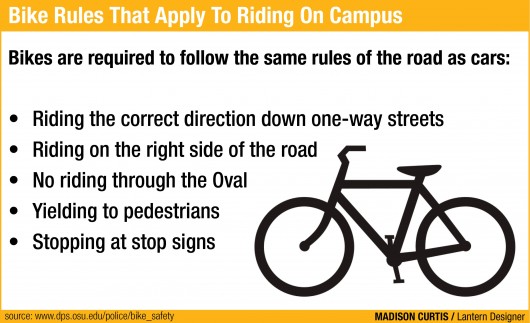
With at least 10 construction sites under way at Ohio State and other various no bike zones in place, some students who bike around campus are realizing what their limitations are.
The Oval and South Oval were named walk zones in April, meaning bikers and skateboarders are required to dismount in those areas.
Some students said enforcing a dismount zone is too broad of a goal.
Chris Watkins, a fourth-year in landscape architecture, said bike safety could be encouraged in a different way, one that restricts bikers less.
“It’s dumb,” said Watkins, who rides his bike on campus. “I understand they want biking on the street, but for the Oval, that’s not feasible. They should accommodate it for bikes instead of just saying ‘no.’”
Genevieve Simon, a fourth-year in theater, said she’s discouraged with the inconsistency of bike routes on campus.
“It is harder (to bike) in some ways. Sometimes things are blocked without notice. I only bike on the street, I feel safer around cars than I do with people,” she said. “I’m frustrated with how inconsistent the Oval is — they’re attacking one group of people (bikers) when there are groups of people (walking) with headphones that aren’t always looking.”
Steven Platko, a third-year in neuroscience, said he rides his bike through the Oval despite the dismount zone rule.
“It (the bike-free zone) is kind of easy to avoid,” he said.
Platko added having rules where bikes must stay off sidewalks ends up slowing down traffic.
“Treating a bike like a car does not work,” he said.
James Balata, a fourth-year in computer science and engineering, said as a pedestrian, he doesn’t think bikers should be allowed to ride on the sidewalks.
“I don’t feel safe with bikers weaving in and out in front of me,” Balata said.
He also said the dismount zone is effective in its safety message.
“I do feel safer crossing campus,” Balata said. “I believe it’s fine sharing the road, but bikers have to follow the rules of the road … We should be stricter when bikers are not following the rules.”
Simon, though, was critical of the bike-free zone policies.
“It’s a hard policy to enforce,” Simon said. “I know they want to educate, but instead of educating some (of the bikers), they should educate all.”
Some students are unclear about the rules of the road altogether. Brandon Brush, a first-year in mechanical engineering, said he is unsure whether the sidewalks and streets are off-limits to bike riders because many people still use them.
“I’m a little confused if we’re supposed to use the sidewalk,” Brush said. “I see the signs saying not to ride on the sidewalk, but most people still do.”
In an effort to increase safety and reduce the amount of accidents on campus, Ohio State created the Share the Road campaign and a task force last year.
OSU created the Traffic Safety Task Force in September 2012 after three traffic incidents on or adjacent to campus left OSU students with major injuries.
It is not only the bicyclists who have to be cautious when travelling in and around campus, but also everyone they come into contact with, said Lindsay Komlanc, OSU spokeswoman for Administration and Planning.
“Traffic safety requires participation from all modes of transportation – pedestrians, bicyclists and motorists,” Komlanc said. “That’s why the university’s Share the Road campaign addresses all modes of transportation.”
The Share the Road campaign is also responsible for the signs around the sidewalks and roads on campus, which designate the site as a bike-free zone.


